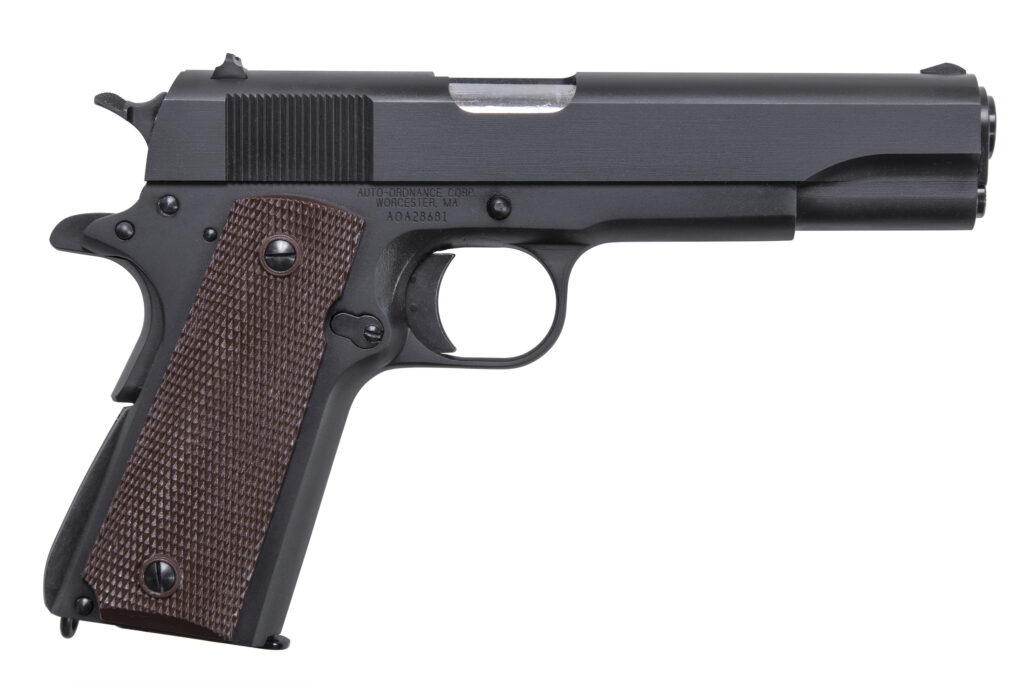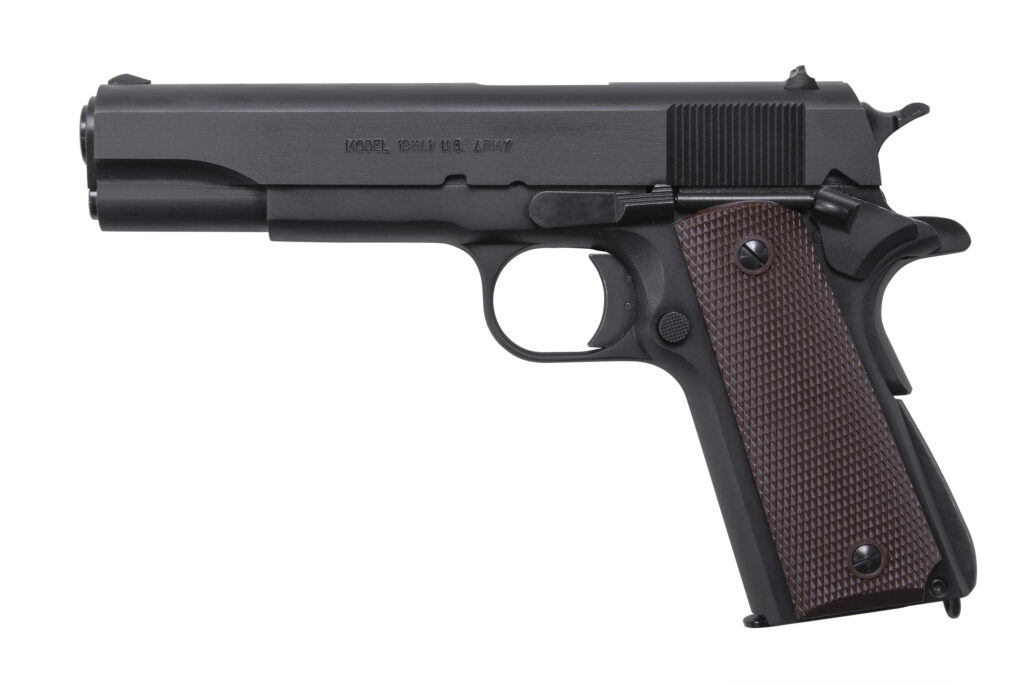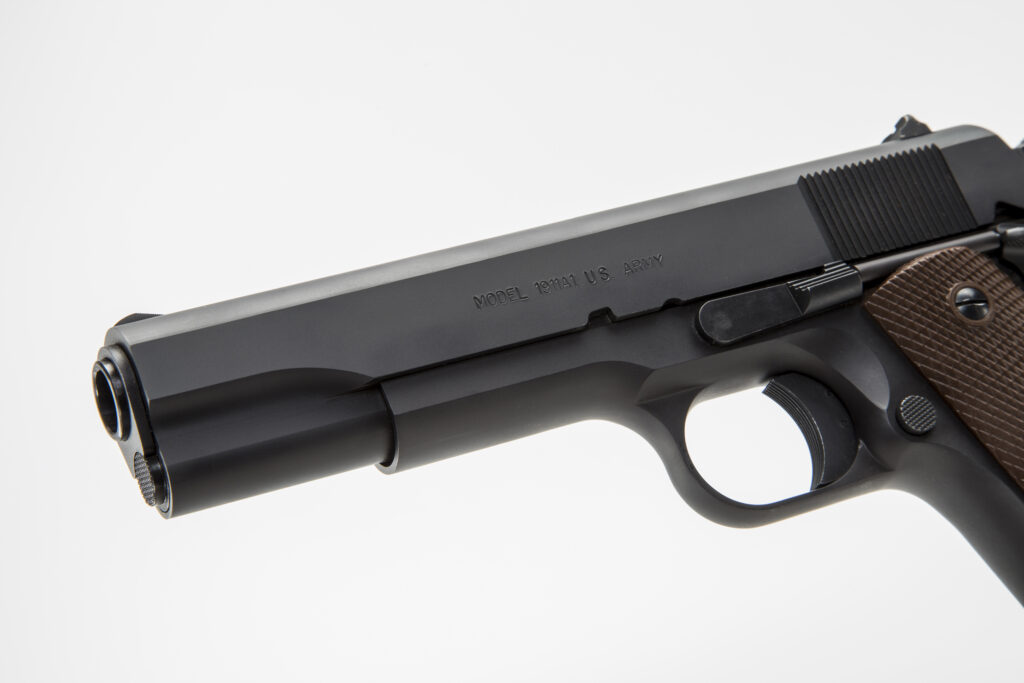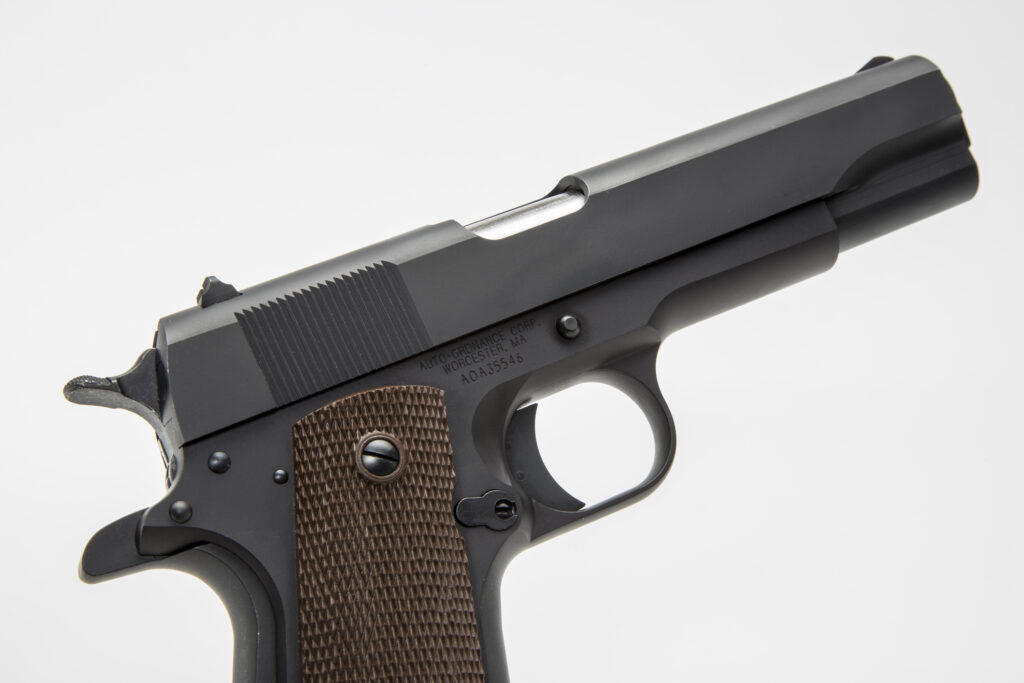
By Jim Dickson | Contributing Editor
The story of the Auto-Ordnance M1911A1 began in 1981 when Numrich Arms, which owned the name Auto-Ordnance, began producing the M1911A1.
Not many were made the first year as they got the production line up and running but 1982 saw full production in swing. An average of 10,000 per year were made each year until 1998 when Kahr Arms bought the rights to Auto-Ordnance and took over manufacture of the M1911A1 and the semi-auto M1927A1 Thompson.
Until then Numrich had made the pistol in .45 ACP, .38 Super, 9MM, and 10MM. There was also a cut down version called the Pitbull which had a normal size grip but a 3 ½-inch barrel. The regular M1911A1 was offered in both parkerized and blue finish plus a few were made with a satin black chrome finish. They also made commemorative pistols with gold finish for the American Historical Foundation in Richmond, Virginia commemorating WW1, WW2, the Korean War, the Viet Nam War, as well as a commemorative edition for each branch of the armed services.
After 1998 Kahr Arms took over the manufacture and has been producing them ever since. I have owned 2½ of their M1911A1 pistols. The half is the complete slide assembly that I got from them so I could convert an Argentine Colt Ace .22 back to .45 ACP as needed. As an interesting aside, the Argentines like to caseharden parts, a fact I quickly discovered as I set out to reduce that pistol’s 15 pound trigger pull down to a more manageable 8 pounds. They also like extremely long hammer spurs producing the only M1911 hammer ever to hammer bite me. That got shortened as well.

Both of the Auto-Ordnance M1911A1’s came from the factory with excellent trigger pulls. Their machining and finish is beyond reproach as well.
The two complete guns are a series 70 and a series 80, the latter having the Colt firing pin blocking safety. The only way the inertia firing pin of the M1911A1 can hit the primer without the hammer falling on it is if the gun is dropped from a great height and lands square on its muzzle. Why anyone would worry about that is beyond me but Colt added the parts to prevent it firing in that scenario and other makers followed Colt’s lead.
The series 70 gun is a little tighter than I like a service gun to be but the series 80 is just perfect. You can wiggle the slide a bit when it is forward in battery but the locking lugs engage snug in the slide and the front bushing is tight but not so tight that you can’t remove it with your fingers. These are the two key areas that determine a service M1911A1’s accuracy. The slide should have some play but not too much. Otherwise it cannot work in the mud, dust, sand, and rust of combat.
Far too many manufacturers make tight fitted M911A1’s that will never prove reliable in combat and combat is the M1911A1’s reason for being. A military issue M1911A1 has the loose tolerances it needs to throw out the sand and dirt as it is fired, something the M1911A1 does better than any other pistol ever made. I have seen a M1911A1 throw sand out of every joint as it kept firing without letup. In sharp contrast to this I have seen reports that the Army’s M9 pistol, drawn clean from a holster, jammed before the magazine could be emptied in an Iraq sandstorm while the M1911A1’s still in service kept right on firing.
All three of my guns are accurate and will group two inches or less at 25 yards and all three will put their bullets inside the kill zone of a silhouette target at 300 yards. People who don’t shoot a lot just don’t appreciate just how far the pistol is capable of reaching. I shoot a lot and I can tell you that 15,000 rounds does not affect accuracy or reliability of these pistols at all.
Life of Service
The M1911A1 in government service generally lasts about 250,000 rounds thanks to ordnance rebuilds during its lifetime. Contrast that to many famous more recent automatic pistol designs that have a design life of only 5000 rounds. Some of them don’t even last that long.
In WW2 the normal service testing of a new lot of M1911A1’s consisted of pulling one gun from the shipment and firing 10,000 to 15,000 rounds without failures and all parts still in good condition. The test pistol was then put back in that shipment and sent out to the troops.
As a hunting cartridge the FMJ .45 ACP has the power to kill anything in North America. You don’t want expanding bullets for big game with the .45 as you need the penetration of the FMJ and you already have a big enough hole to get the job done. This is important if your adversary is an enraged bear or moose.

Reliability in the world’s worst conditions is where the M1911A1 has no peer. It keeps on firing when all the others stop.
There are several reasons for this. Reliability was the most important goal of the army during the intense period of development of the M1911A1. The gun is made out of solid steel with no plastic, aluminum, or sheet metal parts.
The M1911A1’s single column magazine is far more reliable than the double column single position feed pistol magazines that are all the rage today. I have seen these high capacity magazines with cartridges jarred out of position when they are only partially loaded and receive a hard jolt resulting in the magazine jamming and not feeding its cartridges to the gun.
Their feed lips are more prone to damage and none of them can be left loaded for decades with no problems like the M1911A1’s magazines have always done. My personal carry M1911A1 is a WW2 issue .45 that was new when it first came into my hands. I am still using the original magazines which have been kept constantly loaded ever since WW2 except for when being fired. This gun has been my constant companion through many a dangerous spot. I rarely fire it in practice reserving other M1911A1’s for that because I like to shoot 200 rounds a day and that adds up quickly.
At the Range
For this article I put 1310 rounds through these three Auto-Ordnance guns consisting of 500 rounds of Black Hills 230 grain FMJ (my favorite load for everything I shoot with a M1911A1), 500 rounds of Black Hills 185 grain Tac XP+P, 250 rounds of Norma 230 grain FMJ, 60 rounds of Hornady185 grain XPT, The guns are still delivering the 2 inch groups at 25 yards.
It is vital to your survival to do all practice shooting with one hand instead of two. If you practice just with one hand you can still use two if time and circumstances permit which they may not. The reverse is definitely not true. If you do all your practice holding a gun in both hands you will be unable to use it with just one hand at peak efficiency and that can get you killed in a tight fix. The ability to move from a target on one side to one on the other also is seriously slower when using two hands as opposed to one hand. Practicing shooting with two hands is like shooting from a bench rest with a rifle. Nice but it does you no good when you have to take an offhand shot at a deer.
A pistol needs a holster and there are two designs that surpass all others for this pistol. For open carry the Army M1916 hip holster is the best. A full flap design it offers the maximum protection practical yet it is still unsurpassed as a fast draw holster. To do a fast draw from it first make sure it is tied down to the leg. The Army issues leather shoelaces for tie downs but these soon rot and break. I use old army nylon boot laces. Now as you bring your gun hand up, flip the flap open with your thumb and in one motion beginning with your little finger start wrapping your fingers around the grip as you pull the gun out of the holster.
The M1916 holster is currently made by both El Paso Saddlery and Pacific Canvas and Leather Company, the latter also making the web belt and magazine pouch for it.

For concealed carry nothing beats the pancake holster design. El Paso Saddlery makes a fine pancake holster for the M1911A1.
A lot of people who can’t shoot a pistol like to denigrate its value in combat but the pistol fills its own tactical niche that no other weapon can fill. At close range in the jungle, fighting inside houses and buildings, and in the trenches there is nothing faster. In WW1 the Germans made good use of the Luger once they were at close quarters with the enemy in the trenches. As a tactical weapon the Luger played a big part in Germany’s evolving tactics. Every Storm Trooper had one and there were plans for every front line soldier to have one by 1919. The tactical use of the Luger was enabling the Germans to begin to get the upper hand until England managed to drag the U.S. into the war.
In the U.S. we have always had pistoleros who excelled with the pistol and used it in preference to the long arm until the ranges became farther than they were comfortable with. Unlike the long arm, the pistol is always with you for emergencies. No one can keep a long gun in their hands 24 hours a day. You have to lay it down to use your hands for other things. The ability to do a fast draw and fire has saved many lives over the years when there was no time to pick up the long gun. Anyone who has ever had to take time out on the front lines to clean his weapon knows the pressure you feel while the gun is out of action. This leads to poor maintenance and malfunctions leading to dead soldiers. Having a pistol on your hip takes the pressure off as you have one or the other ready for action at all times. This means better maintenance and more lives saved.
Because it is the only gun that you can always have on you ready for action your pistol is the most important gun you own.
The M1911A1 was built to be the most reliable combat automatic possible and it was built to last. It remains the pinnacle of military pistol design as it has for over 100 years. New designs come and go (and often go very quickly if shot much) but the M1911A1 remains the best. Do you really want to trust your life and the lives of your family to less?



